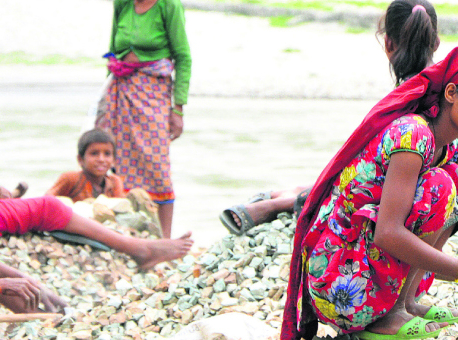
OR
Nepal’s labor market features gender-based wage discrimination
Published On: April 29, 2019 06:30 PM NPT

KATHMANDU, April 29: The constitution has, in its Preamble, guaranteed equal status to men and women, promising to eliminate discrimination based on class, caste, region, language, religion and gender and all forms of caste-based untouchability.
Gender equality remains as the spirit of the country’s law, but in practice, gender-based discrimination largely prevails in every sector in the context of Nepal including in the labour market. According to a report issued by the Central Bureau of Statistics (CBS) recently, women face discrimination in terms of wages in the labor market.
Nepal Labour Force Survey 2017-18, unveiled Friday manifests this. Monthly income of employed women and those in paid job on average is Rs 17, 809 while this figure is counted at Rs 19,464 in case of male counterparts and women’s monthly income is Rs 13,630 and it means that Nepali working women earn 30 percent (Rs 5,834) less than male.
The report highlights that Nepali working women have been deprived of the enjoyment of their rights granted by the constitution. According to the National Census 2011, women’s population is 13,645,463 and men’s population is 12,849,041. In terms of the standard classification of occupation, five areas are ahead in view of the distribution of employment which is highest in the agriculture, forestry, and fishing (21.5 per cent) followed by 17.5 per cent in wholesale and retail trade; 15.1 per cent in repair of motor vehicles and motorcycles; 13.8 per cent in industry and construction and 7.9 per cent in education.
The report states that the presence of women is found increasing especially in the agriculture sector. Similarly, the number of women is more in labor underutilization compared to males. Total 32 per cent males are in labor underutilization while the same is 48.8 per cent for women. As per the report the unemployment rate in the country is 11.4 per cent. In this also, the unemployment rate of women is more compared to the male. The unemployment rate of male and female is 10.3 per cent and 13.1 per cent respectively.
Likewise, seen in terms of areas, the rate of unemployment is more in urban areas. The unemployment rate in the urban areas is 11.6 per cent whereas it is 10.9 per cent in the rural areas. Out of the average 44 hours a week of the main work time, the work time for males is 48 hours and for females, it is 39 hours. As per the report, 37.8 per cent activities fall under the formal economy while 62.2 fall under the informal economy.
The report states that a population of 7,086,000 out of the population of 20,744,000 of 15 years and above age group is found engaged in one or the other form of employment. In this, when 4,446,000 males are employed only 2,640,000 females are employed. It is stated that only 1.2 per cent employment is found in lesser high-level managerial positions.
In this also there is a big gap between males and females. When 86.8 per cent males are the managers, the same for the females is only 13.2 per cent. Although the neighboring country India has made a mandatory provision of having one female in high management, the same is not implemented in Nepal. The constitution has made provision for compulsory 33 per cent women participation in all state agencies, this provision also is not fully in practice in the country. RSS
You May Like This

Room to grow
As an American, I have seen how currently living in the United States is difficult for many minorities, for multiple... Read More...

Gender, Economic Activity & Equality
The relationship between economic empowerment, often discussed in relation to employment and income, and gender equality is not straightforward. Increased... Read More...

I believe in my capacity, gender alone is not my identity
Bhawana Ghimire is a well known name in sports management. She was appointed the first female CEO of Cricket Association... Read More...




Just In
- Fixing a win by outlawing dissent damages democracy
- MoHP cautions docs working in govt hospitals not to work in private ones
- Over 400,000 tourists visited Mustang by road last year
- 19 hydropower projects to be showcased at investment summit
- Global oil and gold prices surge as Israel retaliates against Iran
- Sajha Yatayat cancels CEO appointment process for lack of candidates
- Govt padlocks Nepal Scouts’ property illegally occupied by NC lawmaker Deepak Khadka
- FWEAN meets with President Paudel to solicit support for women entrepreneurship







_20220508065243.jpg)





Leave A Comment